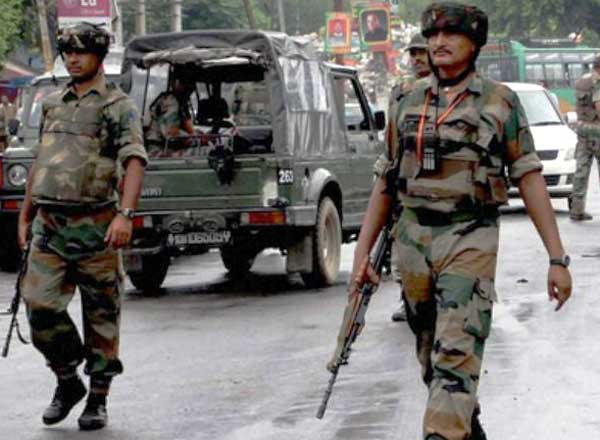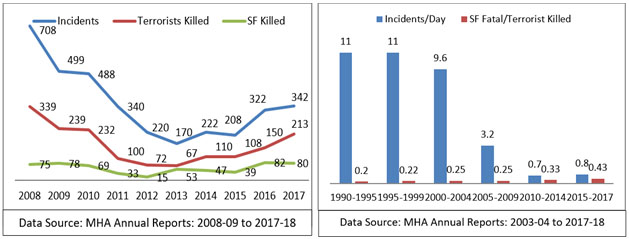 In a latest attempt by the central government to provide a healing touch in Kashmir, counter insurgency operations were suspended during the month of Ramzan. The positive initiative of the government did not yield the desired results as the terrorists attacked army posts, killed a journalist and abducted a soldier going home for Eid who subsequently lost his life in the senseless cycle of violence. The violence cycle actually increased during the ceasefire period again highlighting the fact that terrorism does not have any religious sanctity and follows its own destructive path.
In a latest attempt by the central government to provide a healing touch in Kashmir, counter insurgency operations were suspended during the month of Ramzan. The positive initiative of the government did not yield the desired results as the terrorists attacked army posts, killed a journalist and abducted a soldier going home for Eid who subsequently lost his life in the senseless cycle of violence. The violence cycle actually increased during the ceasefire period again highlighting the fact that terrorism does not have any religious sanctity and follows its own destructive path.
The genesis of J&K’s insurgency traces itself to India’s independence. Pakistan’s frustration on Maharaja of Kashmir ceding to India spurred it to make attempts to wrest the region by force. Obsession with Kashmir by the Pakistani Army has resulted in four wars which led to its humiliating defeat every time. However, failure in all its endeavours got an impetus in 1980s when Pakistan got involved in supporting the JKLF movement which advocated independence of Kashmir. Pakistan’s involvement changed the narrative of insurgency from independence to merger with Pakistan. As it diverted the excess terrorists fighting in Afghanistan, the canvas amplified to tie down Indian Army in Counter-Insurgency duties. The last two decades has seen an intense counter-insurgency tussle by the Indian army as well as CRPF units and the collective effort have thwarted the reprehensible designs of Pakistani army.
An analysis of last two decades indicates diverse facets of insurgency. The initial years of early 1990s saw large number of incidents with a high of 5938 incidents in 1995 and a low of 170 incidents in 2013. The first 15 years from 1990 to 2004 witnessed over 2500 terrorist incidents every year with lowest being in 2004 at 2565 incidents. The trend changed from 2005 which witnessed a sharp decrease in the number of incidents especially after 2007 when the number of incidents dropped to below 1000 and reached a low of 170 incidents in 2013. The numbers increased post 2013 with 2017 witnessing 342 terrorist incidents.
 Though the number of incidents dwindled from average of 11 incidents a day in the 1990s to less than one incident per day from 2010 onwards, the fatal casualties of security forces have increased in the last two decades. For every one terrorist killed in 1990s, the SF casualties were 0.2 which has now doubled to 0.43 SF personnel martyred per terrorist killed in 2017.
Though the number of incidents dwindled from average of 11 incidents a day in the 1990s to less than one incident per day from 2010 onwards, the fatal casualties of security forces have increased in the last two decades. For every one terrorist killed in 1990s, the SF casualties were 0.2 which has now doubled to 0.43 SF personnel martyred per terrorist killed in 2017.
Essentially, terrorism whether used as a strategic asset or as an instrument of terror poses the same dilemma for the state as to how to create a safety net to deny the advantage to the terrorist. The critical components are resources and manpower. The terrorist will always possess an element of surprise and local population support, the SF personnel are always at the receiving end as they are reacting to terrorist attack in majority of cases. Thus, having tried various combinations of hard and soft rule and great leeway by encouraging dialogue with various stakeholders, the recent targeting of civilian areas along IB and repeated violations along LC, it is evident that Pakistan will not alter its policy of actively supporting terrorism in J&K. India policy makers need to adopt an open steel glove policy to rein in the terrorist elements. Indian SF forces practice utmost restraint while conducting operations. Sufficient videos and photographs of SF personnel practicing restraint while being subjected to stone throwing and attacks on their vehicles are available on social media and news channels.
Also, given the fact that there are several subservice elements within the society who are encouraging and supporting terrorism in Kashmir, resolute steps are a must in firmly tackle the menace. There is a need to implement few of hardline practices followed by Israel or USA in tackling terrorists. Policy of restraint needs a quick overhaul. SF personnel must have clearly defined rules of engagement in terms of stone throwing public. Collateral damage has to be acceptable in such cases, but a single SF casualty must not be tolerated. When these norms are acceptable, terrorist activities will witness a sharp drop. Another vital facet to be paid attention to is the insensitive reporting by the media. Media management is paramount given its penchant for glorifying terrorists like the case of Burhan Wani. Though vernacular media will resort to sensational reporting, the main stream media must be encouraged to air unbiased news.
Special status to J&K under Article 370 continues to be a matter of intense debate. It needs to be removed in the present environment of insurgency so that there are no special provisions and the writ of the central government is applicable equally to any state. Another significant factor fuelling the insurgency is the disproportionate allocation of central grants to J&K which has resulted in social and financial security of the local population. As per a report published in The Hindu, J&K received 10 percent of central grant between 2000-2016 with only one percent of national population. It implied that J&K received 1.14 lakh crore which was one fourth of total allocation earmarked for 11 special category states . A comparison shows that J&K received Rs 91,300 per person whereas UP with 13 percent of population received only Rs 4,300 per person in the last sixteen years . Given the fact that some percentage of these funds may have been diverted to support insurgency, the state must not get higher share of central grants and bringing the share of grants equal to other states is a necessity to quell the terrorist acts.
The radicalization of small segment of local population must be countered by government’s outreach programmes to wean away the larger segment of society and regular outreach efforts must continue. Local political outfits will tend to exploit the sentiments by advocating a soft approach toward terrorist groups and at times may even seem to be taking a biased stance, but they have to be encountered with well-planned strategy. SF operations must continue to be conducted with high tempo to neutralise maximum terrorists. A synergy by security forces, state functionaries and a clear and decisive political direction coupled with frustrating Pakistan’s efforts to push terrorists across the LC will yield slow but steady results in the near future.
Courtesy: http://www.claws.in/1918/counter-insurgency-operations-in-jk-future-steps-ashwani-gupta.html




